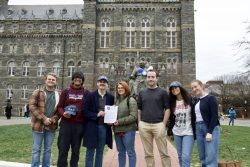D.C. police began wearing body cameras yesterday as part of a six-month pilot program that spreads dozens of camera-equipped officers across the city’s seven police districts. This is a common-sense, pragmatic, and effective action that will benefit both District citizens and its law enforcement officers.
District Police Chief Cathy Lanier seems to agree. At a news conference last Wednesday, she stated that she expects the cameras to cut complaints against officers by as much as 80 percent.
Police body cameras have significant potential to rehabilitate relations between citizens and officers of the law—relations that have been especially strained as of late by the events in Ferguson and other recent high-profile instances of police misconduct. A year-long study of Rialto, Calif. conducted by the nonprofit Police Foundation found that mandating police to wear body cameras reduced incidents in which officers used force by 60 percent. The study also observed a reciprocal benefit for officers, who registered 88 percent fewer complaints during the assessment period. Not surprisingly, in cases where force was used, it was twice as likely to have been applied by officers who were not wearing cameras.
Calls for police body cameras have not been limited to D.C. Last week, Federal Judge Shira Scheindlin delivered a speech at the Bronx County Bar Association promoting police body cameras as a solution to nationwide incidences of police violence.
“In Staten Island, an unarmed man was killed by policemen arresting him for trafficking in untaxed cigarettes, and in Ferguson, Missouri, an unarmed teenager was shot six times and killed by police officers,” Scheindlin said. “If the police in both of those encounters had been wearing body cameras, I expect that neither incident would have ended with a dead body.”
The evidence sides with Sheindlin. Polls demonstrate that at least on a state-by-state basis the general public largely supports the use of body cameras, and not by slim margins. Fully 80 percent of Utahns and 68 percent of Floridians favor them according to reports from recent surveys. America’s three largest cities—New York, Los Angeles, and Chicago—have all either implemented or announced upcoming body camera programs.
In a society dominated by ever-greater forms of surveillance, whether online via the NSA or in person through the lens of an airborne drone, police body cameras provide a welcome reprieve. Here is a welcome instance of state-sponsored technology injecting safety and civility into perhaps the most tense, notorious, and dangerous interactions between citizen and state. If all parties involved know they are being recorded during a police encounter, and that such recordings could potentially incriminate them in a court of law, they are more likely to adjust their behavior. Amid rampant toxicity, cameras offer police and citizens a rarity—an instance in which justice and doing the right thing align irrefutably.





“Amid rampant toxicity, cameras offer police and citizens a rarity—an instance in which justice and doing the right thing align irrefutably.”
Atrocious writing.